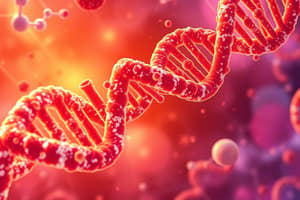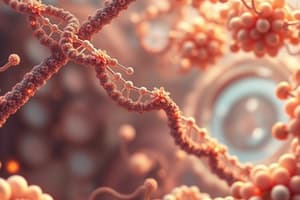Podcast
Questions and Answers
What is the primary function of DNA Polymerase during DNA replication?
What is the primary function of DNA Polymerase during DNA replication?
- To join Okazaki fragments
- To catalyze the formation of replication forks
- To synthesize complementary DNA strands (correct)
- To unwind the DNA double helix
Which enzyme is responsible for creating the replication fork during the initiation phase of DNA replication?
Which enzyme is responsible for creating the replication fork during the initiation phase of DNA replication?
- DNA Ligase
- Primase
- Helicase (correct)
- DNA Polymerase
In which direction does DNA replication occur?
In which direction does DNA replication occur?
- From 3′ to 5′
- In both directions simultaneously
- From 5′ to 5′
- From 5′ to 3′ (correct)
What forms as a result of discontinuous replication on the lagging strand?
What forms as a result of discontinuous replication on the lagging strand?
How does termination of DNA replication differ among organisms?
How does termination of DNA replication differ among organisms?
What is the primary function of DNA-dependent DNA polymerase?
What is the primary function of DNA-dependent DNA polymerase?
Which enzyme is primarily responsible for the formation of the replication fork by unzipping DNA strands?
Which enzyme is primarily responsible for the formation of the replication fork by unzipping DNA strands?
In eukaryotes, which polymerase is responsible for the polymerization process during DNA replication?
In eukaryotes, which polymerase is responsible for the polymerization process during DNA replication?
What is the role of ligase in DNA replication?
What is the role of ligase in DNA replication?
Which of the following statements is true regarding the differences between prokaryotic and eukaryotic DNA replication?
Which of the following statements is true regarding the differences between prokaryotic and eukaryotic DNA replication?
Flashcards are hidden until you start studying
Study Notes
DNA Replication Overview
- DNA replicates semi-conservatively, producing two copies from one original strand.
- The process involves biological polymerization through initiation, elongation, and termination phases.
- DNA Polymerase is the primary enzyme for catalyzing DNA replication.
Steps in DNA Replication
Initiation
- Replication starts at a specific site known as the origin of replication to ensure accuracy.
- Helicase enzyme creates a replication fork by unwinding the DNA strands.
- Complete unzipping is energy-intensive; thus, it occurs in segments.
Elongation
- DNA polymerases synthesize complementary strands using parental strands as templates.
- DNA is synthesized unidirectionally from the 5' to 3' end.
- Continuous replication occurs on one template strand (3'→5'), while discontinuous fragments (Okazaki fragments) are formed on the other (5'→3').
- DNA ligase is responsible for joining the Okazaki fragments together.
Termination
- In E. coli (circular chromosomes), termination occurs when two replication forks meet.
Key Enzymes in DNA Replication
-
DNA-dependent DNA Polymerase: Main enzyme aiding in the polymerization during DNA replication.
-
Types of DNA Polymerase:
- DNA Polymerase I: Involved in DNA repair and various activities.
- DNA Polymerase II: Responsible for primer extension and proofreading.
- DNA Polymerase III: Main enzyme for in vivo DNA replication.
-
Helicase: Unzips DNA strands by breaking hydrogen bonds, assisting fork formation.
-
Ligase: Joins Okazaki fragments of discontinuous strands.
-
Primase: Synthesizes RNA primers complementary to DNA templates.
-
Endonucleases: Create single-stranded or double-stranded cuts in DNA.
-
Single-stranded Binding Proteins: Protect single-stranded DNA from secondary structures.
Differences in DNA Replication in Prokaryotes and Eukaryotes
- Prokaryotic replication features a simpler process with fewer origins compared to eukaryotes.
- Eukaryotic replication involves multiple origins of replication and a more complex initiation involving a pre-replication complex.
- In eukaryotes, DNA polymerization is carried out by Pol δ, while in prokaryotes, it is performed by DNA Pol III.
Studying That Suits You
Use AI to generate personalized quizzes and flashcards to suit your learning preferences.



